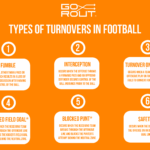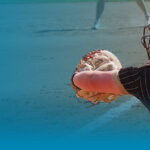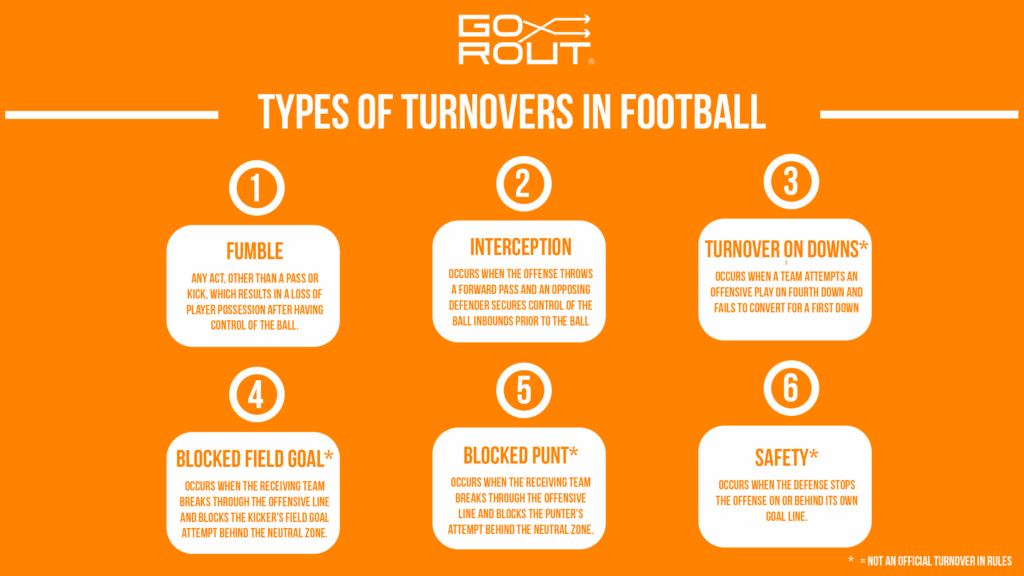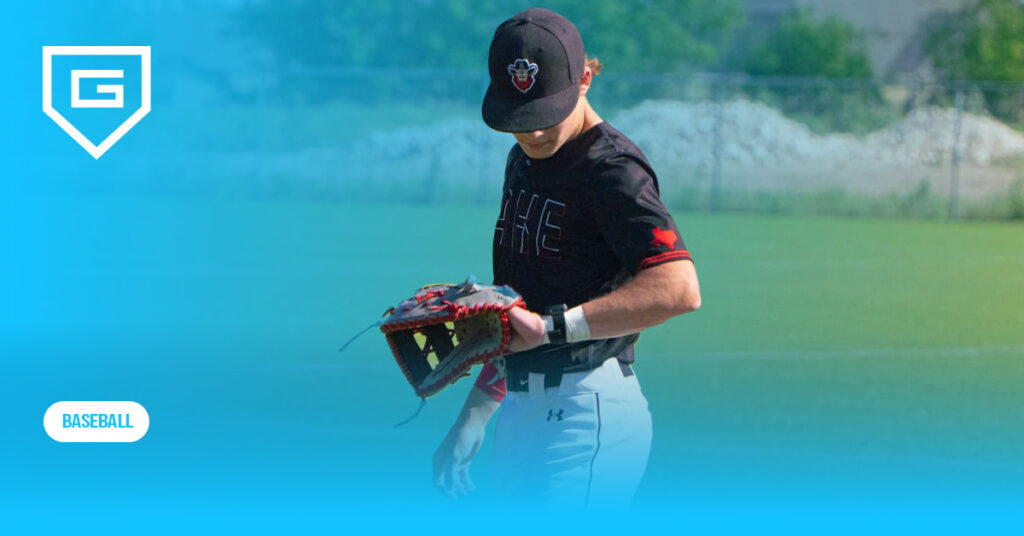Softball Hitting Tips: How To Improve At The Plate
Reading Time: 11 minutes
Reading Time: 11 minutes
Hitting is one of the hardest skills to master for softball players of all ages and experience levels. The softball hitting tips in this resource will provide assistance and guidance to help you improve as a batter.
Because the distance from the pitcher to home plate is relatively short, softball hitters need a quick swing with fast reaction time and bat speed to maximize their abilities. It takes a combination of technique and form, practice and repetitions, mental preparation, and confidence to be a great hitter in softball.
Whether you’re just starting out, an experienced player, or a coach looking for ways to guide your girls, this resource is for you. In this post, we’ll be specifically speaking to fast pitch softball – not slow pitch.
Continue reading to learn about
- Tips on hitting technique and form
- Tips and tricks to improve bat speed
- Mental preparation tips
- Tips to select the right gear and equipment
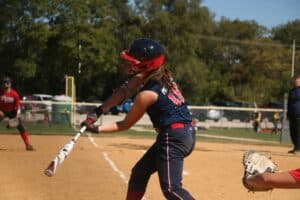
Tips on Technique and Form
Fundamentals are the foundation of your swing, specifically your technique and form. If your technique and form is sound, you’re more likely to find success at the plate.
Some high-level tips for hitting technique and form in fast pitch softball include:
- Hold the bat in your fingers with a loose grip
- Relax in your stance and swing to avoid restriction and resistance
- Maintain a square, level stance with feet shoulder width apart and knees bent in an athletic stance
- Try to swing with as little movement as possible, especially focusing on keeping your head still
- Focus on a smooth, synchronized swing from load through finish
Your technique and form can be broken down into three categories of focus:
- Grip
- Stance
- Swing Mechanics
In the subsections below, we’ll break down tips and tricks to maximize the impact of each category in greater detail.

Grip
Success at the plate starts with your grip. Hold the bat in your fingers with a relatively loose grip. A loose grip reduces tension and resistance, enabling you to move freely and get the most power out of your swing. By holding the bat in the base of your fingers, you avoid positioning it too deep in your palms and risking a restrictive “chokehold” grip.
You want to find a happy medium though. If your grip is too loose, you won’t have control of the bat. If you hold it too tight, you reduce your flexibility and movement which impacts bat speed and swing path.
To ensure you hold the bat properly in your fingers, line up your “door knocking” knuckles with your dominant hand on top and your non-dominant hand underneath. Your top hand and bottom hand should be touching.
Depending on the situation or your experience level, you can adjust your grip by choking up and gripping higher up on the handle. This shortens the bat and gives you more control. Choking up can be helpful when you’re protecting with two strikes, facing faster pitching, or just looking for more control with your swing.

Stance
Your batting stance is how you’re positioned at the plate and directly impacts your performance. As with your grip, a relaxed stance is crucial. That stands true in many facets of softball. While your entire body should be relaxed, focus on avoiding tension in your shoulders.
As you step into the batters box, establish a level stance with your feet shoulder width apart and knees bent in an athletic stance for balance. Your chest should face the dugout in front of you and your front shoulder aligned with the pitcher.
Try to keep a square stance with your front and back feet aligned. This reduces movements in your swing and the distance to contact point. Some players use an open stance (front foot open) or a closed stance (front foot closed) that require more movement. As long as you get squared in time for contact, it’s all personal preference.
- A right handed batter would position their left foot toward third base if they had an open stance. A left handed batter would position their right foot toward first base for an open stance.
Hold the bat above your back shoulder with your hands near your ear. This gets you in a ready position and prepares you for a short, direct loading motion.

Swing Mechanics
Proper swing mechanics include little movement, a short and compact swing path, and smooth coordination.
Through your entire swing, keep your head still and eyes behind the barrel. This ensures you keep your eye on the ball — maximizing hand eye coordination — and don’t move too much, negatively impacting your swing path.
Synchronize your swing. Load your hands and legs together, focusing on a singular, smooth motion from load through swing. It takes your entire body to swing, so make sure you aren’t just using your arms.
Keep your shoulders level throughout – any dip back or forward will result in weak contact, pop ups, or swing and misses.
Your elbows should point down at the beginning of your stance and you should keep your hands separate from your body at stride.
As you swing, tuck your back elbow in tight to your body. Keep your weight behind your front side, with a strong front leg. You want your chest to stay behind your belly button. If you don’t control your weight, it all shifts to your front side too early and leaves you in a poor position.
Swing all the way through from shoulder to shoulder to finish strong. From start to finish, you need to keep your momentum going. This results in a complete swing and helps you hit the ball hard.

Tips and Tricks to Improve Bat Speed
Bat speed is important for solid contact and hitting with power. Many of the tips mentioned above on technique and form simultaneously improve bat speed.
Here are the key tips and tricks to improve bat speed in fastpitch softball:
- Maintain a loose grip in your fingers for quicker movement, less restriction, and more power
- Have a relaxed stance with no tension; tension reduces bat speed
- Load your hands and legs together to keep your swing synchronized and reduce resistance. Less resistance improves bat speed.
- Keep your elbow relaxed and pointed down toward the ground to swing with gravity. Holding them higher up fights the natural force of gravity and introduces resistance to your swing.
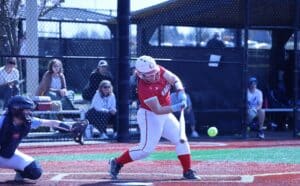
Mental Preparation Tips
While the physical components of softball play a major role in your performance, your mentality is equally as important. Mental preparation – especially for hitting – has several aspects to focus on. A combination of positive attitude, confidence, focus, and visualization
From the start, it’s important to remember that hitting is difficult for anyone and everyone to master. It takes a great deal of mental preparation and strength to battle through.
As with the physical components, relaxation is key. One way to remain level-headed is to control your breathing. There are different exercises to work on controlling your breathing.
Positive Thinking and Self Confidence
Positive thinking and self-confidence is essential to success at the plate. You need to have confidence in yourself, and a positive mindset fuels belief in oneself. Practice and hard work play a role in this. You’re more likely to be confident in your abilities if you stay consistent with practice and continually work on fundamentals through various softball drills.
Goals
Focusing on specific goals can help you define “success” in your head. You can set performance goals like number of hits, or fundamental goals like remembering to keep your weight back. Learning from past failures (either during the game, from previous games, or in practice) is helpful to improve future at bats.
Visualization
Visualization is the process of creating mental images of a situation. In softball hitting, visualization is when you imagine – or visualize – the desired outcome of an at-bat. When you’re on-deck, visualize your at-bat and where you want the ball hit. With each pitch, watch the pitcher’s movement and swing as if you were the one at the plate. This helps you work on timing before you get to the plate, as well as visualizing your at-bat.
Approach
Finally, focus on your approach. No matter the situation, aim to stay inside the ball. Split the ball in half and aim to make contact with the inside half of the ball. Focusing on the inside half gives you a better chance of hitting a straight, hard line drive toward right center field (or left center field for lefties), versus rolling over and hitting a weak ground ball by focusing on the outer half.
- Part of your approach is understanding how to be selective. You need to be able to decipher a good pitch from a bad pitch in a split second.
As you’re on-deck and then approaching the plate, consider the situation you’re in and how you want to approach it.
- If there’s a runner on third base in a tie ball game with less than two outs, you may aim to hit a high fly ball to right field for a sacrifice fly. Your approach would involve looking for a pitch you know you can drive to the outfield the other way (if you’re a right handed batter).

Tips To Help Select The Right Equipment And Gear
The equipment and gear doesn’t make a hitter, but it can help improve your performance and provide more comfort. Feel good, play good. There are a few factors to consider when selecting softball hitting equipment and gear.
Bat Size and Type
Consider your size and strength when selecting a softball bat. You want to find the right length, weight, and style of bat.
- To find the right length, place the knob at the center of your chest. If your fingertips can reach the barrel, it’s likely a good length. When your hand goes way past it, you’ll want to select a longer bat. If you can’t reach it, opt for a shorter one.
- To find the right weight, consider your strength and personal preference. If you’re a bigger power hitter, you can use a heavier bat without losing swing speed. Smaller players may prefer a lighter bat.
The two main types of softball bats are composite and aluminum. There are pros and cons to both. Consider the following when selecting a composite softball bat versus an aluminum one.
- Composite softball bats usually have a larger sweet spot and less of an impact on mishits, but they are more expensive and need to be broken in.
- Aluminum softball bats are more affordable and game-ready right away. However, they don’t have as large of a sweet spot as composite bats and mishits can hurt your hands more.
Hitting Accessories
Outside of your bat, batting gloves and cleats can play a direct role in your performance at the plate.
- Batting gloves provide additional grip support and control. They also protect you from getting blisters and can absorb some of the vibration from mishits, reducing pain. Some factors to consider when selecting batting gloves include fit, material, grip, and breathability. Look for an option that fits snug yet comfortable, leaves you with free range of motion, and enhances your grip.
- Cleats provide traction and support for your feet in your swing. Without them, you might slip or lose your balance in the process of swinging. In youth leagues, you’ll likely have to use rubber cleats. High school softball leagues and anything more advanced than that likely allow you to wear metal cleats, which provide the best traction.
Though it doesn’t directly impact your performance, caged batting helmets protect your entire head – including your face – from incidental contact. With a caged helmet protecting your face, you can stand confident that you’ll be safe no matter what happens. That confidence helps you attack the pitch with everything you have.
- When selecting a helmet, make sure it fits snug but not too tight. Look for something breathable and ensure that the face mask doesn’t block your view of the pitcher.
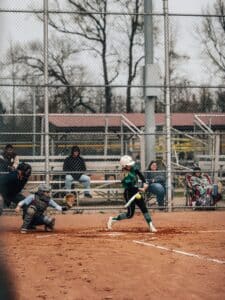
Conclusion
With these tips for hitting in softball, you’ll feel more confident and prepared next time you step up to the plate. Remember to consistently work on technique and form.
Use the tips that we provided and incorporate them into your daily practice routine – whether with your team or independently at home. If you’re a coach, share these tips with your players at your next practice to level up your softball coaching.
Some of the key takeaways from this resource should be:
- Relax and reduce tension at every part of your swing and approach
- Keep a loose grip using your fingers
- Maintain a level, balanced stance
- Aim for a smooth, synchronized swing with little-to-no head movement
- Practice mental preparation, positive attitude, self-confidence, and visualization
- Carefully select your gear and equipment for batting
FAQs About Softball Hitting Tips
How do you get better at hitting a softball?
You need to work on fundamentals, technique and form, bat speed, and mental preparation to get better at hitting a softball. Practice is essential. Whether with a team or independently at home, you should work on the fundamentals every day to improve your swing.
If you have access to public batting cages, you don’t even need a partner. Bring a tee and work on stationary drills. Practice different types of swings, including hitting to the opposite field or making solid contact on an inside pitch.
How do you become a good hitter in softball?
To become a good hitter in softball, you need to establish solid fundamentals like technique and form. Practicing consistently is important as you’ll notice slow but steady progress over time.
It’s also important to have confidence in yourself and build mental strength to improve your mindset at the plate. One way to improve confidence is to be aware of the strike zone. Practice against live pitching and get to know what looks like a strike versus a ball.
How do you hit bombs in softball?
Bat speed, reaction time, and physical strength all play a role in hitting for power in softball. There are practice exercises and workouts for each component that you should work on to become a better power hitter.
What exercises improve hitting power in softball?
To improve hitting power, you can work on a variety of strength exercises that build core strength, explosiveness, and rotational power.
Some examples include:
- Squats
- Deadlifts
- Medicine ball throws
- Plyometrics
You should also work on your bat speed and reaction time to become a more powerful hitter. Focus on a relaxed stance, minimal tension or resistance, and a smooth, synchronized swing.
Why can’t I hit a softball?
There are several reasons why someone wouldn’t be able to hit a softball. You may lack experience, be practicing the wrong drills, or struggle with mental hurdles.
If you’re inexperienced, the first step to take is to gain experience. Practice swinging in your backyard, find friends to play pickup games with, or join your local softball league. It doesn’t matter if you can’t hit it out of the infield, any bit of experience helps you learn and grow.
You can work on softball hitting drills to develop and hone fundamentals, solid technique, and proper form.
Mental preparation and self-confidence is important to success in softball hitting. If you’re putting in the time to practice physically, it’s also important that you work on building confidence and mental strength to become a complete batter.
Why is a softball harder to hit?
Hitting in softball is often considered more difficult than in baseball because:
- The shorter distance from the pitchers rubber to home plate gives batters less time to react, and
- The trajectory of a softball pitch rises, which makes it harder for hitters to make contact
How do I get over my fear of getting hit by a softball?
To overcome a fear of getting hit by a softball, you have to understand how to get hit, develop mental strategies to overcome the fear, and have exposure to live pitching.
Learning to drop the bat barrel and turn away from the pitcher ensures that your most vulnerable parts are protected from contact. Using softer tennis or whiffle balls can help players practice taking a hit, face live pitching, and feel more confident at the plate.
How do you gain bat speed in softball?
To gain bat speed in softball, you should:
- Hold the bat in your fingers with a loose grip
- Keep your shoulders relaxed to reduce tension
- Load your hands and legs together to keep a synchronized swing
- Keep your elbows relaxed and pointed down to the ground
The key to bat speed is relaxation – it reduces tension and resistance, allowing maximum flexibility and unrestricted movement.
How do you get stronger in hitting a softball?
You can get strong in softball hitting by working on fundamentals, practicing softball hitting drills, and building strength outside of the game. Improving your strength and bat speed will lead to more power.
Your practice and approach will likely change depending on whether you’re playing fast pitch or slow pitch softball.

